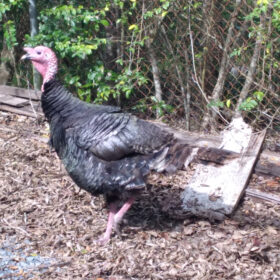By Pat Foster-Turley

There is an avian mystery happening on Amelia Island, and maybe someone out there has an idea that explains it. During the past year, wild turkeys have been spotted on the island, and no one seems to really know where they came from. About a year ago, people were remarking on a female wild turkey that was hanging around near the Harris Teeter parking lot. When I first heard these reports, I was (falsely) confident that people were actually seeing peahens, which have been introduced into neighborhoods around Scott Road and have roamed in the area for years. But no, one early reporter, Jeff Kennard, was adamant that it was a turkey, and he was right. And finally, Bucko and I saw this turkey hen, too.
Lately, she has not been seen, but now another wild turkey has also shown up on the island. Tammi Kosack contacted me about a month ago after she sighted a wild turkey, this time in and around her yard near the Port of Fernandina. This turkey turned out to be a young male, not the other single turkey, the female, seen mid-island. I paid Tammi a visit, and she showed me where the turkey often strolls along the hedgerow bordering the cleared lot next to her house and all along the edges of the nearby warehouse where some weeds have been left to grow. I didn’t manage to see this turkey, but Tammi provided many photos, even showing this brazen turkey looking in through her glass door.

We have some wild habitat in the state parks on the north and south ends of Amelia Island and along the Egans Creek Greenway, but as far as I know, no one has spotted any turkeys there, at least in our 30-some years on the island, so this does not seem to be their source. And the rangers have not seen any wild turkeys on Big or Little Talbot Islands either.
There have long been wild turkeys on Cumberland Island. Turkeys can only fly short distances but maybe a turkey managed to hit the wind just right and managed to fly over to Amelia Island. And, in the past few years, rangers have seen more and more wild turkeys in Pumpkin Hill Creek Preserve State Park just across the marsh from us. Could they have originated there? This may be just the beginning of a new population of wild turkeys on Amelia Island.

Wild turkey populations have increased in suburban areas along the East Coast of the United States. In fact, while I was preparing this column, I received an email from family members in Long Island, New York, who are also seeing their own groups of wild turkeys roaming their yards for the first time. Turkeys are intelligent birds that are opportunistic in their feeding choices, enabling them to eat insects, fruits, berries, and seeds that they can glean from neighborhood patches of brush and plants. In Tammi’s yard, the maybe six feet of vegetation along her property edge is just enough to provide them with a corridor to travel through as they visit the yards in the area. Now that a couple of turkeys have found us, but not yet each other, most likely, the days will come when wild turkey sightings are a common occurrence in our midst.

I, for one, enjoy the idea of wild turkeys inhabiting our island. I admire any wild animal that can coexist with us in our human-dominated world. Only those adaptable and/or bold individuals who can accept the proximity of humans will continue to survive on this planet with us. Over time, some of these species will adapt to us as the rest of the world’s biodiversity disappears. Maybe wild turkeys will be one of the surviving species.
Two sub-species of wild turkey are possible in our area — the eastern wild turkey that ranges in the Eastern United States south to North Florida and the Florida wild turkey that is found from here southwards. At this point, there is no telling which variety we have, or even if we will ever have more. It will be interesting to see what happens next. If you have seen a wild turkey on Amelia Island or in our state parks, please let me know, and we can follow this maybe-range extension of wild turkeys together.
There’s always something!
Pat Foster-Turley, Ph.D., is a zoologist on Amelia Island. She welcomes your nature questions and observations. [email protected]
